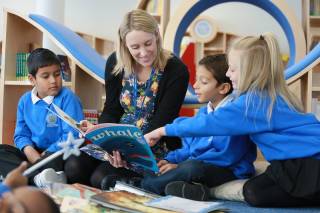Reading Recovery implementation have enabled to create a powerful school response to the needs of struggling learners.
Sir Michael Wilshaw was recently asked to identify some inspirational schools that he felt were doing an excellent job of meeting the needs of pupils learning in disadvantage. Amongst the handful of schools he named was Whitefield Community primary school in Liverpool. With above average numbers of children eligible for pupil premium funding and speaking English as an additional language, the executive head teacher is often asked to identify what it is that makes the school so successful in the face of adversity. She answers that it is an unstinting focus on getting children able to read and wanting to do so that makes for their impressive results.
The school has been implementing Reading Recovery for 10 years now. They regard it as integral to meeting the needs of the pupils in their school. The senior management team consider that being part of Liverpool’s Reading Recovery implementation have enabled them to create a powerful school response to the needs of struggling learners. It does this in some key ways.
- The school consistently offers four Reading Recovery teaching slots. This enables eight of the lowest attaining literacy learners to be targeted each year. This number of children allows the school to ensure that all pupils are able to read and write proficiently by the beginning of Key Stage 2. They don’t have children going into KS2 as non-readers. This means that there is no need to engage with catch up programmes and expensive resources for struggling readers. They see success at six as crucial if school to build comprehension and reading for pleasure are to be effective.
- Reading Recovery is seen as a mechanism through which to build professional knowledge and skills. The school have adopted a rolling programme of training. So after a few years of implementing Reading Recovery, the teacher is deployed in a different role, often managing or coaching others, and a further staff member is trained. The school currently have three trained Reading Recovery teachers and are considering identifying a further teacher to train. These three teachers mentor other staff to use diagnostic assessments and advise on the sort of intervention and teaching approach to use in lighter-touch interventions. School staff consider that through this approach, they have a shared language through which to liaise effectively about literacy learning and teaching.
- The school make identifying pupils showing signs of beginning to fall behind a priority. Having several Reading Recovery teachers means that the use of diagnostic assessments can become more widespread and used systematically they provide a safety net of early identification.
- A strategic vision for literacy across the school is shared by all staff. An identified member of staff (an ex Reading Recovery teacher) acts as a Reading Strategy Manager. She coordinates approaches for reading for pleasure and organises as many opportunities as possible for children to read, making sure reading mileage is high; with each other, in guided groups, independently and with adults.
- Using the approaches underpinning Reading Recovery, the model of reading they have adopted to surround their school development is an inclusive one. Classrooms are language-rich, with high quality text used for teaching, for independent reading and home-school reading; the use of decodable books is reserved for phonics lessons where children follow a systematic programme to learn grapheme-phoneme connections and how to decode; picture books are used in reading aloud activities and for free choice to motivate and engage children; storybooks using natural language are carefully selected for guided reading and independent reading and Reading for pleasure.
- Having every pupil reading by the end of Key Stage 1 allows the school to build pupil ownership. Upper KS2 pupils act as librarians, making book recommendations weekly to their peers, via a reading celebration assembly. Pupils are given opportunities to nominate books they would like to have in the school library. Librarians run a daily lunchtime library story time and organise outdoor reading resources. Strategies to engage pupils, including vulnerable pupils, would not be effective if all pupils were able to read. The Head teacher says “Reading Recovery helps us make our school effective.”
When asked what would happen if they stopped implementing Reading Recovery, their Reading Strategy Manager said
"It would be catastrophic. Not only would the needs of the struggling readers not be met early and effectively, but so many pupils would be unable to access many of the engaging experiences we offer especially as they moved into KS2. We have got used to everyone becoming a reader by the end of Year 2 I can't imagine the cost, both human and financial, of reverting back to the levels of attainment we experienced before we had Reading Recovery. This intervention is an effective tool for improving the life chances of the most deprived and vulnerable children".
Given the efficacy of the approach the school has taken, the governors have continued to support Reading Recovery as the corner stone of literacy provision in KS1.
“Whitefield gained a judgement of Outstanding in their last inspection in November 2017. In the report, inspectors paid tribute to the strategic vision that supports the school strategies. This vision, the head teacher says, is founded on the principles of Reading Recovery.
 Close
Close


